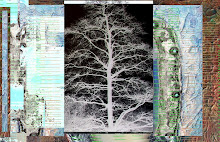Share and share alike ---- let me know if helpful. I thought I would meander here with bad "how too's" and not clutter the main blog.
The almost final image is in my typo
wasteland. Conjured mostly from the tree picture, below, with some goldfish added and then stir fried. Use Canola oil.
This is the starting image - already a manipulation - the kissing cousin of the posts done recently. Notice the cedar wax wings at the lower left.
.bmp)
I used MS Picture Manager - a program great for cropping but even better for saturation and tone changes - my favorite app for that, but it is for the entire image. It is very important to "save as" and then not save changes to the original when you close the Manager. Let's call this altered image "ALT_1" for reference purposes.

Next you should download paint.net here. It is free unless you want to donate. It is much stronger than MS Paint, although I still like old Paint for a few things I will not go into here, yet. Paint.net handles larger files well for editing, it has layers, great effects, etc - it is very nice.
I used square option in paint.net and then I used effect to change median and then played with hues before moving to another area. Then some copy and pastes to modify composition. Below is "ALT_2." Looks different, no?

Next I reopened ALT_1 into paint.net and did a "select all" and "copy." In ALT_2 I created a layer, went to layer properties and made it an "overlay" and lowered the opacity. I "pasted" in the image (ALT_1) and then merged the layer down. I did a "save as" and made ALT_3. In paint.net keeps you working with just altered saved image.

I reopened the image ALT_2 in paint.net and copied and pasted a part of it back into ALT_3. "Saved as" Alt_4, below.

I opened a goldfish photograph, and then using the "magic wand" (and also altering the tolerance) I got some part of goldfish into the main image. Copy, switch image, and then a paste into the working image.

Next I used "square" tool change tones and then I highlighted thin vertical slice and then I did "color invert." I copied the inversion and placed it over parts of image, keeping a certain compositional intent.

Inversion is a cheap trick to get you a complimentary. Strong hint: you could use certain paint.net alterations to modify the color, tone etc, a bit less obvious "inversion."

In background, above, is my son, Alex dressed like Harry Potter for Halloween..
I utilize Hue/Saturation, Curves and Levels, depending.....and it works on area you selected with square, circle or wand, etc. I do not use the circle.
We are closer, but still fishing.......to finish I opened and did a copy of an earlier image in this set (I forget which) and then pasted it in layer that I had modified to "multiply." Again, I might have gone to layer properties and played with opacity. Suddenly I saw what I liked and then I did a series of cut and pastes, playing with tones and contrast a wee bit. Without warning, I was largely done - the process suddenly was fast and magical. Trance like, but subtle. Time froze or sped up, I am not sure.
Until then the process had been experimenting, trying, learning, and getting lost and found. Then, short term vision. Done, unless I decide to further modify the bottom right....which I did a morning later - that image has not been posted yet.
What would you do with this image? Let's use the Socratic method, but with kindness.
Email me if you wish to be a contributor to this blog and I will add your name so you can post examples, questions, or whatever.
Perfect spelling will not be tolerate\d/
































.bmp)







